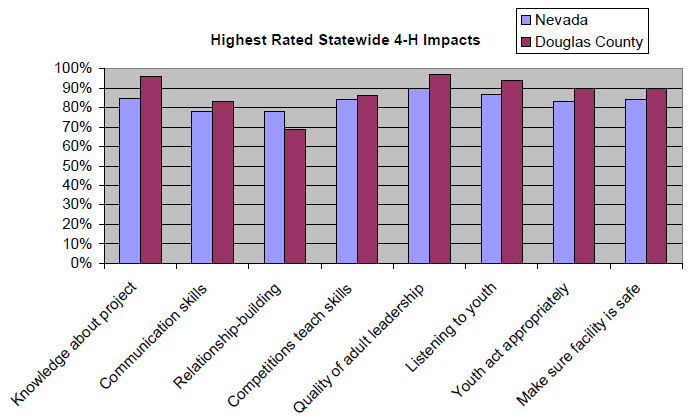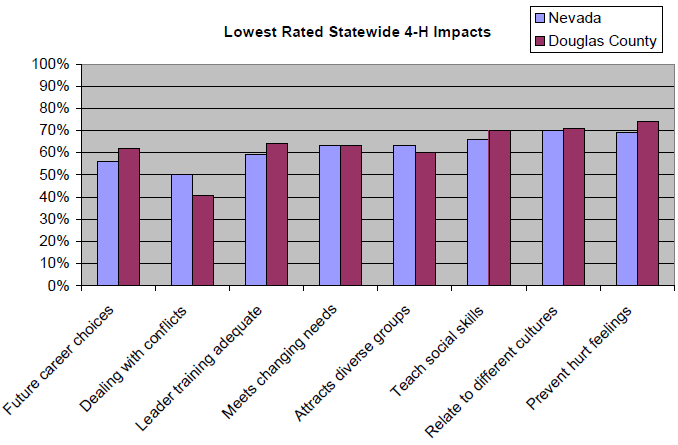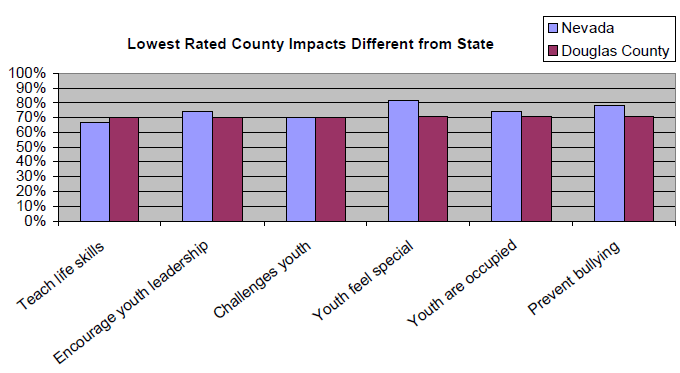Introduction
In continued efforts to assess 4-H program impacts, in 2003, University of Nevada Cooperative Extension surveyed all 4-H parents and leaders statewide. The results were analyzed statewide and by county (Singletary & Smith, 2004). Understanding impacts at the county level is important because 4-H programs in Nevada are managed at the county level. This fact sheet reports the impact assessment results statewide, highlighting Douglas County. The purpose of this report is to inform 4-H parents, leaders and youth members about how 4-H impacts their lives and assist 4-H professionals in developing an action plan to further strengthen Douglas County 4-H.
Designing and Conducting the Assessment
In designing a tool to assess 4-H program impacts, two models for youth development were used. The first model is based upon six outcomes to expect from successful youth development. These outcomes are confidence, competence, caring, connection, contributing and character (Blyth, 2000).
Successful youth development helps children become: confident they can make a difference; competent through their ability, skills, and knowledge, and; able to work with people in a way that develops and promotes caring relationships. These youth connect beneficially with people and organizations, contribute their services to make a difference in their personal development as well as in their community, and demonstrate responsible and honest character, or a sense of who they are.
The second youth development model used to develop the assessment questions focuses on “core concepts” and provides a basis for successful youth development programs in Nevada (UNCE, 1993). Such programs produce youth who:
- learn and practice self-responsibility and social responsibility to feel accountable and in control of their lives;
- recognize when and how to make informed decisions and implement decisions to solve a problem or achieve goals;
- communicate effectively in both verbal and written form, to share thoughts and feelings which increase social competence, and;
- obtain career and occupational information to help prepare for the world of work.
Questions developed for this assessment were based upon the six desired outcomes of positive youth development and Nevada’s core concepts for teaching life skills. Combining the two models resulted in a suite of questions that assess the effectiveness of 4-H: to teach youth life skills and social skills; traditional 4-H program teaching tools; and program management goals.
Additional questions assessed adult skills to work with youth as established by the National Committee on Community Programs to Promote Youth Development (Eccles and Appleton- Gootman, 2002). These include parent and volunteer leader skills to teach youth; manage programs and; prevent negative or high-risk behavior among 4-H youth. These questions were designed to assess the indirect impacts of Nevada 4-H on parents and volunteer leaders.
Participants in the assessment included all parents and adult volunteer 4-H leaders currently enrolled statewide and in Douglas County. These participants were selected based on the rationale that 4-H leaders and parents of 4-Hers have the most frequent opportunity to observe any changes that occur among youth participating in 4-H programs.
Each individual was mailed a two-page questionnaire with instructions along with a selfaddressed and stamped return envelope. Also included was a cover letter that explained the purpose of the survey, ensured confidentiality to participants, and thanked them for their participation. Of the 3,074 survey recipients, 576 returned completed questionnaires resulting in a 19 percent response rate statewide. Douglas County’s response rate was 16 percent and represented 5 percent of the statewide response.
County Impacts Compared with Statewide Impacts
On a scale of 1 to 5 with “1” being “very low” and “5” being “very high,” respondents were asked to circle the number that best indicates how effectively 4-H is developing youth and impacting the adults involved. The results are presented by highest and lowest ratings. Results from Douglas County are presented alongside statewide impacts for comparison purposes.
The highest rated statewide impacts are shown in Figure 1 along with Douglas County impacts. Individual question labels below each bar set specify the abbreviated survey questions. Similarly, Figure 2 illustrates lowest rated impacts statewide along with Douglas County results.
impacts generally mirror the statewide results, with countywide ratings comparatively higher than statewide on almost all impacts. For example, the top life skill Douglas County youth learn is knowledge about the project(s) (96% countywide and 85% statewide). The highest rated social skill Douglas County youth learn is improved communication (83% countywide and 78% statewide, tied with relationship-building (69% countywide and 78% statewide). In terms of 4-H teaching tools, Douglas County rated highest 4-H competitions and shows teach my child valuable skills (86% countywide and 84% statewide). Douglas County’s highest rated program management goal is quality of adult leadership is key to effective 4-H programs (97% countywide and 90% statewide). For Douglas County 4-H parents and leaders, the highest rated teaching skill is listening to youth (94% countywide and 87% statewide); program management skill is ensuring youth act appropriately (90% countywide and 83% statewide); and prevention skill is making sure the facility where we have 4-H is safe (90% countywide and 84% statewide).
Figure 2 illustrates areas to improve in Douglas County 4-H, which also tend to mirror the state. The lowest rated life skill youth learn is learning about future career choices (62% countywide and 56% statewide). The lowest rated social skill youth learn is dealing with conflict (41% countywide and 50% statewide). The lowest rated 4-H teaching tool is volunteer leader training is adequate in providing the skills needed to lead projects (62% countywide and 59% statewide). The lowest rated program management goal statewide tied 4-H meets the changing needs of youth in my community (62 % county and statewide) with 4-H attracts diverse culture and ethnic groups (62% statewide and 60% countywide). Regarding 4-H parent and leader skills, Douglas County’s lowest rated skills slightly surpass the state’s lowest rated skills.
Finally, Figure 3 illustrates the lowest rated impacts for Douglas County that differ from the statewide results. For example, Douglas County’s lowest rated parent/leader teaching skills is a three-way tie with each rated at 70 percent for the county. These are providing activities that teach life skills (67% statewide); encouraging youth to take leadership roles (73% statewide) and providing activities that challenge youth (70% statewide). Douglas County rated the lowest parent/leader program management skill helping youth feel like they belong to a part of a special group (71% countywide and 81% statewide) tied with making sure youth are occupied (71% countywide and 73% statewide). Also, Douglas County rated the lowest parent/leader prevention skill keeping youth from bullying one another (71% countywide and 79% statewide).
Figure 1. Highest Rated Statewide 4-H Program Impacts Compared with Douglas County

Data From Figure 1
Figure 2. Lowest Rated Statewide 4-H Program Impacts Compared with Douglas County

Data From Figure 2
Figure 3. Douglas County Lowest Rated 4-H Program Impacts Different from State

Data From Figure 3
Developing an Action Plan to Strengthen Douglas County 4-H
The Extension Educator and 4-H professionals in Douglas County analyzed the county’s highest and lowest rated impacts in order to understand the survey results. Considerations included Douglas County’s generally positive program impacts ratings overall.
To develop an action plan to strengthen Douglas 4-H further, Extension and 4-H professionals examined the lowest rated impacts along with available demographic information. Table 1 illustrates these demographics for Douglas County.
One particularly notable item concerns Douglas 4-H enrollment’s low share (3%) of the total number of school-age children countywide. It also appears that Douglas 4-H tends to reach mostly white, middle-income families.
The resulting Douglas County 4-H action plan will seek to increase 4-H enrollment countywide and seek greater diversity in member recruitment. Also, leader training should be modified to:
- Strengthen teaching skills, with special regard to challenging and engaging youth through experiential learning;
- Provide more opportunities for youth to practice leadership in 4-H;
- Demonstrate ways in which leaders can help youth to feel they belong to a special group and;
- Examine methods for preventing and addressing bullying behavior among 4-H youth..
Finally, since youth skills for dealing with conflict and leader/parent skills for managing conflict among youth, including preventing bullying, were identified among lower rated impacts countywide, the action plan for Douglas County 4-H includes the following three objectives:
- Identify state and area specialists that are willing and interested in working with Douglas County 4-H staff to strengthen 4-H programs to teach life skills useful in dealing with conflicts.
- Co-develop and work with a state and area “conflict management team” to create a plan for addressing this weaker program area including how to best include 4-H youth and leaders in the planning process.
- Seek out conflict management curriculum materials that show the greatest promise for 4- H program applications.
- Improve leader management and teaching skills through leader trainings and strengthen parent skills by sharing information in newsletters and through demonstration.
Table 1. Douglas County Demographics
| Category |
Amount |
| Total number of school-age children in Douglas County |
7,180 |
| Total number of 4-H youth in Douglas County |
200 |
Largest ethnic group of public school enrollment in Douglas County
*(AI/AN) 3% (AS) 2.4% (H) 14% (B) 1% (W) 79.6% |
White (79.6%) |
Largest ethnic group of 4-H youth in Douglas County
(AI/AN) 0% (AS) 0% (H) 3.3% (B) 0 % (W) 83.3% (O) 13.3% |
White (83.3%) |
| Median income of families in Douglas County |
$63,800 |
| The majority of 4-H families in Douglas County earn annually |
$50,000 to 74,099 |
| Percent of families in Douglas County earning below $25,000 annually |
20% |
| Percent 4-H families in Douglas County earning below $25,000 annually |
10% |
| * AI/AN=American Indian/American Native, AS=Asian, H=Hispanic, B=Black, W=White, O=Other |
Conclusions
This fact sheet reported the results of the 2003 Extension 4-H program impact assessment comparing highest and lowest rated impacts for Douglas County with statewide results. It is intended to inform 4-H parents, leaders and youth members how 4-H impacts their lives and also assist Extension and 4-H professionals in developing an action plan to further strengthen Douglas County 4-H.
The resulting action plan for Douglas County 4-H will seek to increase enrollment and create a more diverse membership base. In terms of specific program content, teaching and management goals, Douglas County 4-H will strengthen volunteer leader training to address the lowest rated aspects of our county program as well as share information with parents through newsletters and demonstrations.
Efforts are currently underway in the majority of Nevada’s counties to develop action plans to strengthen 4-H programs. The resulting action plans will serve as guidelines for strengthening 4-H in a positive, objective manner, and to continue to generate new ways in which 4-H can make the best better.
References
- Blyth, D. 2000. Extension’s Roles in Community Youth Development for the 21rst Century. Communication and Educational Technology Services, University of Minnesota Extension Service.
- Eccles, J., & Appleton-Gootman, J. (Eds.). 2002. Community Programs to Promote Youth Development. Washington, DC: National Academy Press.
- Singletary, L. & Smith, M. 2004. Nevada 4-H Statewide Impact Assessment. EB-04-01. University of Nevada Cooperative Extension.
- University of Nevada Cooperative Extension. 1993. Youth Development in Nevada, Core Concepts: A Framework for Programming. Tri-fold Brochure. University of Nevada, Reno.
Figure 1. Highest Rated Statewide 4-H Program Impacts Compared with Douglas County
| Category |
Nevada |
Douglas County |
| Knowledge about project |
85% |
96% |
| Communication skills |
78% |
83% |
| Relationship-building |
78% |
69% |
| Competitions teach skills |
84% |
86% |
| Quality of adult leadership |
90% |
97% |
| Listening to youth |
87% |
94% |
| Youth act appropriately |
83% |
90% |
| Make sure facility is safe |
84% |
90% |
Figure 2. Lowest Rated Statewide 4-H Program Impacts Compared with Douglas County
| Category |
Nevada |
Douglas County |
| Future career choices |
56% |
62% |
| Dealing with conflicts |
50% |
41% |
| Leader training adequate |
59% |
62% |
| Meets changing needs |
62% |
62% |
| Attracts diverse groups |
62% |
60% |
| Teach social skills |
67% |
70% |
| Relate to different cultures |
70% |
71% |
| Prevent hurt feelings |
69% |
74% |
Figure 3. Douglas County Lowest Rated 4-H Program Impacts Different from State
| Category |
Nevada |
Douglas County |
| Teach life skills |
67% |
70% |
| Encourage youth leadership |
73% |
70% |
| Challenges youth |
70% |
70% |
| Youth feel special |
81% |
71% |
| Youth are occupied |
73% |
71% |
| Prevent bullying |
79% |
71% |


